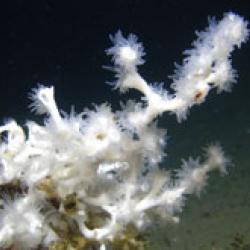Source Institutions
Source Institutions
Add to list Go to activity
Activity link broken? See if it's at the internet archive

In this activity, learners explore the factors that tend to resist changes in pH of the ocean and why the ocean is becoming more acidic. This lesson guides inquiry into some properties of the ocean’s carbonate buffer system, and how changes in atmospheric carbon dioxide levels may affect ocean pH and biological organisms that depend upon calcification. This lesson was first created for the 2008 Deepwater Coral Expedition: Reefs, Rigs, and Wrecks, but has been updated in 2009 to include recently published information.
- 30 to 45 minutes
- 1 to 2 hours
- Over $20 per group of students
- Ages 14 - 18
- Activity, Experiment/Lab Activity, Lesson/Lesson Plan
- English
Quick Guide
Materials List (per group of students)
- Copies of Ocean Acidification Inquiry Guide
- Copies of Ocean Acidification: A Summary for Policymakers from the Second Symposium on the Ocean in a High-CO2 World (optional)
- Protective goggles and gloves
- 100 ml glass beakers
- 100 ml graduated cylinders
- 500 ml glass beaker
- 2 - 1 liter beakers or Erlenmeyer flasks for mixing solutions
- Glass stirring rods
- Sodium hydroxide pellets, approximately 50 grams (see Learning Procedure Step 1)
- Solid citric acid (to neutralize sodium hydroxide spills); approximate 450 grams
- Distilled water
- Artificial seawater
- pH test paper, wide range
- Dilute acetic acid solution in dropper bottles
- 0.1 M sodium hydroxide solution in dropper bottles
Subjects
-
Earth and Space Science
-
Earth Processes
- Weather and Climate
-
Earth Structure
- Oceans and Water
- Atmosphere
-
Earth Processes
-
Life Sciences
-
Diversity of Life
- Plants
- Animals
-
Ecology
- Ecosystems
- Human Impact
-
Diversity of Life
-
Mathematics
-
Algebra
- Equations and Inequalities
-
Data Analysis and Probability
- Data Analysis
- Data Collection
- Data Representation
- Reasoning and Proof
- Representation
-
Algebra
-
The Nature of Technology
-
Technology and Society
- Technology and the Environment
-
Technology and Society
-
Physical Sciences
-
Chemistry
- Chemical Reactions
- Acids and Bases
- Chemistry of Life
- Solutions
-
Structure and Properties of Matter
- Elements and Periodic Table
- Elementary Particles and Nuclear Physics
-
Chemistry
-
The Nature of Science
-
Science and Society
- Risks and Benefits
-
The Scientific Process
- Conducting Investigations
- Gathering Data
- Formulating Explanations
- Communicating Results
-
Science and Society
Informal Categories
- Animals
- Nature and Environment
Audience
To use this activity, learners need to:
- see
- see color
- read
- touch
Learning styles supported:
- Involves teamwork and communication skills
- Involves hands-on or lab activities
Other
Includes alignment to state and/or national standards:
Includes assesments for student learning:
This resource is part of:
Access Rights:
- Free access
By:
- Office of Ocean Exploration, NOAA
Rights:
- All rights reserved, NOAA,
